Nonlinear Optics in Microspherical Resonators
Abstract
1. Introduction
2. Kerr Effects
2.1. Third-Order Sum-Frequency Generation
2.2. Four-Wave Mixing
2.3. Stimulated Raman Scattering
2.4. Stimulated Brillouin Scattering
3. Kerr Switching in Hybrid Resonators
4. Two-Photon Fluorescence
5. Conclusions
Author Contributions
Funding
Acknowledgments
Conflicts of Interest
References
- Chiasera, A.; Dumeige, Y.; Feron, P.; Ferrari, M.; Jestin, Y.; Nunzi Conti, G.; Pelli, S.; Soria, S.; Righini, G. Spherical whispering-gallery-mode microresonators. Laser Phot. Rev. 2010, 4, 457–482. [Google Scholar] [CrossRef]
- Rayleigh, L. The problem of the whispering gallery. Philos. Mag. 1910, 20, 1001. [Google Scholar] [CrossRef]
- Qian, S.X.; Chang, R.K. Multi-order Stokes emission from micrometer-size microdroplets. Phys. Rev. Lett. 1986, 56, 926–929. [Google Scholar] [CrossRef] [PubMed]
- Dumeige, Y.; Trebaol, S.; Ghisa, L.; Nguyen, T.K.N.; Tavernier, H.; Féron, P. Determination of coupling regime of high Q resonators and optical gain of highly selective amplifiers. JOSA B 2008, 25, 2073–2080. [Google Scholar] [CrossRef]
- Ilchenko, V.; Gorodetsky, M.; Vyatchanin, S. Coupling and tunability of optical whispering gallery modes—A basis for coordinatemeter. Opt. Commun. 1994, 107, 41–48. [Google Scholar] [CrossRef]
- Sumetsky, M.; Dulashko, Y.; Windele, R.S. Super free spectral range tunable optical microbubble resonator. Opt. Lett. 2010, 35, 1866–1868. [Google Scholar] [CrossRef] [PubMed]
- Shu, F.; Zhang, P.; Qian, Y.; Wang, Z.; Wan, S.; Zou, C.L.; Guo, G.; Dong, C. A mechanically tuned comb in a dispersion-engineered silica microbubble resonator. Sci. China-Phys. Mech. Astron. 2020, 63, 254211. [Google Scholar] [CrossRef]
- Henze, R.; Seifert, T.; Ward, J.; Benson, O. Tuning whispering gallery modes using internal aerostatic pressure. Opt. Lett. 2011, 36, 4536–4538. [Google Scholar] [CrossRef]
- Madugani, R.; Yang, Y.; Le, V.H.; Ward, J.M.; Nic Chormaic, S. Linear Laser Tuning Using a Pressure-Sensitive Microbubble Resonator. IEEE Photonics Technol. Lett. 2016, 28, 1134–1137. [Google Scholar] [CrossRef]
- Zhu, S.; Shi, L.; Ren, L.; Zhao, Y.; Jiang, B.; Xiao, B.; Zhang, X. Controllable Kerr and Raman-Kerr frequency combs in functionalized microsphere resonators. Nanophotonics 2019, 8, 2321–2329. [Google Scholar] [CrossRef]
- Zhu, S.; Jiang, B.; Xiao, B.; Shi, L.; Zhang, X. Tunable Brilluoin and Raman microlasers using hybrid microbottle resonators. Nanophotonics 2019, 8, 931–940. [Google Scholar] [CrossRef]
- Razdolskiy, I.; Berneschi, S.; Nunzi Conti, G.; Pelli, S.; Murzina, T.; Righini, G.; Soria, S. Hybrid microspheres for nonlinear Kerr switching devices. Opt. Express 2011, 10, 9523–9528. [Google Scholar] [CrossRef] [PubMed]
- Murzina, T.V.; Berneschi, S.; Barucci, A.; Cosi, F.; Nunzi Conti, G.; Razdolskiy, I.; Soria, S. Kerr versus thermal non-linear effects studied by hybrid whispering gallery mode resonators. Opt. Mater. Express 2012, 2, 1088–1094. [Google Scholar] [CrossRef]
- Carmon, T.; Vahala, K. Visible continuous emission from a silica microphotonic device by third-harmonic generation. Nat. Phys. 2007, 3, 430. [Google Scholar] [CrossRef]
- Lin, H.B.; Campillo, A. CW nonlinear optics in droplet microcavities displaying enhanced gain. Phys. Rev. Lett. 1994, 73, 2440–2443. [Google Scholar] [CrossRef]
- Vogt, D.; Leonhardt, R. Terahertz whispering gallery mode bubble resonator. Optica 2017, 4, 809–812. [Google Scholar] [CrossRef][Green Version]
- Pastells, C.; Marco, P.; Merino, D.; Loza-Alvarez, P.; Quercioli, F.; Pasquardini, L.; Lunelli, L.; Pederzolli, C.; Daldoso, N.; Farnesi, D.; et al. Two photon versus one photon fluorescence excitation in whispering gallery mode microresonators. J. Lumin. 2016, 170, 860–865. [Google Scholar] [CrossRef]
- Lin, G.; Coillet, A.; Chembo, Y.K. Nonliner phtonics with high Q whsipering gallery mode resonators. Adv. Opt. Photonics 2017, 9, 828–890. [Google Scholar] [CrossRef]
- Righini, G.; Dumeige, Y.; Feron, P.; Ferrari, M.; Nunzi Conti, G.; Soria, S.; Ristiić, D. Whispering gallery mode microresonators: Fundamentals and applications. Riv. Del Nuovo Cimento 2011, 34, 435. [Google Scholar]
- Leach, D.H.; Chang, R.K.; Acker, W.P. Stimulated anti-Stokes Raman scattering in microdroplets. Opt. Lett 1992, 7, 387–389. [Google Scholar] [CrossRef]
- Roman, V.E.; Popp, J.; Fields, M.H.; Kiefer, W. Minority species detection in aerosols by stimulated anti-Stokes-Raman scattering and external seeding. Appl. Opt. 1999, 38, 1418–1422. [Google Scholar] [CrossRef] [PubMed]
- Spillane, S.; Kippenberg, T.; Vahala, K. Ultralow-threshold Raman laser using a spherical dielectric microcavity. Nature 2002, 415, 621. [Google Scholar] [CrossRef] [PubMed]
- Matsko, A.B.; Savchenkov, A.A.; Maleki, L. Normal group-velocity dispersion Kerr frequency comb. Opt. Lett. 2012, 37, 43–45. [Google Scholar] [CrossRef] [PubMed]
- Matsko, A.; Strekalov, D.; Ilchenko, V.; Maleki, L. Optical hyper-parametric oscillations in a whispering gallery mode resonator: Threshold and phase diffusion. Phys. Rev. A 2005, 71, 033804. [Google Scholar] [CrossRef]
- Farnesi, D.; Cosi, F.; Trono, C.; Righini, G.C.; Nunzi Conti, G.; Soria, S. Stimulated anti-Stokes Raman scattering resonantly enhanced in silica microspheres. Opt. Lett. 2014, 39, 5993. [Google Scholar] [CrossRef] [PubMed]
- Roos, P.A.; Meng, L.S.; Murphy, S.K.; Carlsten, J.L. Approaching quantum-limited cw anti-Stokes conversion through cavity-enhanced Raman-resonant four-wave mixing. J. Opt. Soc. Am. B 2004, 21, 357–363. [Google Scholar] [CrossRef]
- Maldovan, M.; Thomas, E. Simultaneous localization of photons and phonons in two-dimensional periodic structures. Appl. Phys. Lett. 2006, 88, 251907. [Google Scholar] [CrossRef]
- Rolland, Q.; Oudich, M.; El-Jallal, S.; Dupont, S.; Pennec, Y.; Gazalet, J.; Kastelik, J.C.; Lévêque, G.; Djafari-Rouhani, B. Acousto-optic couplings in two-dimensional phoxonic crystal cavities. Appl. Phys. Lett. 2012, 101, 061109. [Google Scholar] [CrossRef]
- Lu, Q.; Liu, S.; Wu, X.; Liu, L.; Xu, L. Stimulated Brillouin laser and frequency comb generation in high Q microbubble resonators. Opt. Lett. 2016, 41, 1736–1739. [Google Scholar] [CrossRef]
- Hill, S.C.; Leach, D.H.; Chang, R.K. Third-order sum-frequency generation in droplets: Model with numerical results for third-harmonic generation. J. Opt. Soc. Am. B 1993, 10, 16–33. [Google Scholar] [CrossRef]
- Acker, W.P.; Leach, D.H.; Chang, R.K. Third-order optical sum-frequency generation in micrometer-sized liquid droplets. Opt. Lett. 1989, 14, 402–404. [Google Scholar] [CrossRef] [PubMed]
- Leach, D.H.; Acker, W.P.; Chang, R.K. The effect of the phase velocity and spatial overlap of spherical resonances on sum-frequency generation in droplets. Opt. Lett. 1990, 15, 894–896. [Google Scholar] [CrossRef] [PubMed]
- Leach, D.H.; Chang, R.K.; Acker, W.P.; Hill, S.C. Third order sum-frequency generation in droplets: Experimental results. J. Opt. Soc. Am. B 1993, 10, 34–45. [Google Scholar] [CrossRef]
- Chew, H.; Sculley, M.; Kerker, M.; McNulty, P.J.; Cooke, D.D. Raman and fluorescent scattering by molecules embedded in small particles: Results for coherent optical processes. J. Opt. Soc. Am. 1978, 68, 1686–1689. [Google Scholar] [CrossRef]
- Farnesi, D.; Berneschi, S.; Barucci, A.; Righini, G.; Soria, S.; Nunzi Conti, G. Optical frequency conversion in silica-whispering-gallery-mode microspherical resonators. Phys. Rev. Lett. 2014, 112, 093901. [Google Scholar] [CrossRef]
- Asano, M.; Komori, S.; Ikuta, R.; Imoto, N.; Özdemir, Ş.K.; Yamamoto, T. Visible light emission from a silica microbottle resonotar by second and third harmonic generation. Opt. Lett. 2016, 41, 5793–5796. [Google Scholar] [CrossRef]
- Kozyreff, G.; Dominguez-Juarez, J.L.; Martorell, J. Nonlinear optics in spheres: From second harmonic scattering to quasi-phase matched generation in whispering gallery modes. Laser Photonics Rev. 2011, 5, 737–749. [Google Scholar] [CrossRef]
- Chen, J.H.; Shen, X.; Tang, S.J.; Cao, Q.T.; Gong, Q.; Xiao, Y.F. Microcavity Nonlinear Optics with an organically functionalized surface. Phys. Rev. Lett. 2019, 123, 173902. [Google Scholar] [CrossRef]
- Savchenkov, A.A.; Matsko, A.B.; Ilchenko, V.S.; Solomatine, I.; Seidel, D.; Maleki, L. Tunable Optical Frequency Comb with a Crystalline Whispering Gallery Mode Resonator. Phys. Rev. Lett. 2008, 101, 093902. [Google Scholar] [CrossRef]
- Del’Haye, P. Optical Frequency Comb Generation in Monolithic Resonators. Ph.D. Thesis, Ludwig-Maximilians-Universitaet, München, Germany, 2011. [Google Scholar]
- Kippenberg, T.; Spillane, S.; Vahala, K. Kerr-nonlinearity optical parametric oscillation in an ultrahigh-Q toroid microcavity. Phys. Rev. Lett. 2004, 93, 083904. [Google Scholar] [CrossRef]
- Chembo, Y.K.; Strekalov, D.V.; Yu, N. Spectrum and dynamics of optical frequency combs generated with monolithic whispering gallery mode resonators. Phys. Rev. Lett. 2010, 104, 103902. [Google Scholar] [CrossRef] [PubMed]
- Kippenberg, T.J.; Spillane, S.M.; Vahala, K.J. Demonstration of ultra-high-Q small mode volume toroid microcavities on a chip. Appl. Phys. Lett. 2004, 85, 6113–6115. [Google Scholar] [CrossRef]
- Agha, I.H.; Okawachi, Y.; Foster, M.A.; Sharping, J.E.; Gaeta, A.L. Four-wave-mixing parametric oscillations in dispersion-compensated high-Q silica microspheres. Phys. Rev. A 2007, 76, 043837. [Google Scholar] [CrossRef]
- Agha, I.H.; Okawachi, Y.; Gaeta, A.L. Theoretical and experimental investigation of broadband cascaded four-wave mixing in high-Q microspheres. Opt. Express 2009, 17, 16209. [Google Scholar] [CrossRef] [PubMed]
- Liang, W.; Savchenkov, A.A.; Ilchenko, V.S.; Eliyahu, D.; Seidel, D.; Matsko, A.B.; Maleki, L. Generation of a coherent near-infrared Kerr frequency comb in a monolithic microresonator with normal GVD. Opt. Lett. 2014, 39, 2920. [Google Scholar] [CrossRef] [PubMed]
- Coen, S.; Haelterman, M. Modulational Instability Induced by Cavity Boundary Conditions in a Normally Dispersive Optical Fiber. Phys. Rev. Lett. 1997, 79, 4139. [Google Scholar] [CrossRef]
- Dinyari, K.; Barbour, R.; Golter, D.A.; Wang, H. Mechanical tuning of whispering gallery modes over a 0.5Thz tuning range with MHz resolution in silica microsphere at cryogenic temperatures. Opt. Express 2011, 19, 17966–17972. [Google Scholar] [CrossRef]
- Li, M.; Wu, X.; Liu, L.; Xu, L. Kerr Parametric oscillations and frequency comb generation from dispersion compensated silica micro-bubble resonators. Opt. Express 2013, 21, 16908–16913. [Google Scholar] [CrossRef]
- Farnesi, D.; Barucci, A.; Righini, G.C.; Nunzi Conti, G.; Soria, S. Generation of broadband hyperparametric oscillations in silica microbubbles. Opt. Lett. 2015, 40, 4508–4511. [Google Scholar] [CrossRef]
- Yang, Y.; Jiang, X.; Kasumie, S.; Zhao, G.; Xu, L.; Ward, J.; Yang, L.; Nic Chormaic, S. Four-wave mixing parametric oscillation and frequency comb generation at visible wavelengths in a silica microbubble resonator. Opt. Lett. 2016, 41, 5266–5269. [Google Scholar] [CrossRef]
- Yang, Y.; Ooka, Y.; Thompson, R.M.; Ward, J.M.; Nic Chormaic, S. Degenerate four-wave-mixing in a silica, hollow bottle microresonator. Opt. Lett. 2016, 41, 575–579. [Google Scholar] [CrossRef] [PubMed]
- Shuker, R.; Gammon, R.W. Raman-Scattering Selection-Rule Breaking and the Density of States in Amorphous Materials. Phys. Rev. Lett. 1970, 25, 222. [Google Scholar] [CrossRef]
- Min, B.; Kippenberg, T.; Vahala, K. A compact fiber-compatible cascaded Raman laser. Opt. Lett. 2003, 28, 17. [Google Scholar] [CrossRef] [PubMed]
- Kippenberg, T.J.; Spillane, S.M.; Min, B.K.; Vahala, K.J. Theoretical and experimental study of stimulated and cascaded Raman scattering in ultrahigh-Q optical microcavities. IEEE J. Sel. Top. Quantum Electron. 2004, 10, 1219–1228. [Google Scholar] [CrossRef]
- Ozdemir, S.K.; Zhu, J.; Yang, X.; Peng, B.; Yilmaz, H.; He, L.; Monifi, F.; Huang, S.; Long, G.; Yang, L. Highly sensitive detection of nanoparticles with a self-referenced and self-heterodyned whispering-gallery Raman microlaser. Proc. Natl. Acad. Sci. USA 2014, 111, E3836. [Google Scholar] [CrossRef]
- Soria, S.; Berneschi, S.; Brenci, M.; Cosi, F.; Nunzi Conti, G.; Pelli, S.; Righini, G.C. Optical Microspherical Resonators for Biomedical Sensing. Sensors 2011, 11, 785–805. [Google Scholar] [CrossRef]
- Righini, G.C.; Soria, S. Biosensing by WGM micro spherical resonators. Sensors 2016, 16, 905. [Google Scholar] [CrossRef]
- Chistiakova, M.V.; Armani, A.M. Cascaded Raman microlaser in air and in buffer. Opt. Lett. 2012, 37, 4068–4070. [Google Scholar] [CrossRef]
- Ooka, Y.; Yang, Y.; Ward, J.M.; Nic Chormaic, S. Raman Lasing in a hollow bottle like microresonator. Appl. Phys. Express 2015, 8, 092001. [Google Scholar] [CrossRef]
- Soltani, S.; Diep, V.; Zeto, R.; Armani, A. Stimulated anti-Stokes Raman emission generated by gold nanorod coated optical resonators. ACS Photonics 2018, 5, 3550–3556. [Google Scholar] [CrossRef]
- Boyd, R. Nonlinear Optics; Academic Press: Cambridge, MA, USA, 2008. [Google Scholar]
- Shen, Y.R. The Principles of Nonlinear Optics; John Wiley and Sons, Inc.: Hoboken, NJ, USA, 2003. [Google Scholar]
- Stolen, R.H.; Gordon, J.P.; Tomlinson, W.J.; Haus, H.A. Raman response function of silica-core fibers. J. Opt. Soc. Am. B 1989, 6, 1159–1166. [Google Scholar] [CrossRef]
- Grudinin, I.; Matsko, A.; Maleki, L. Brillouin lasing with a CaF2 whispering gallery mode resonator. Phys. Rev. Lett. 2009, 102, 043902. [Google Scholar] [CrossRef] [PubMed]
- Eggleton, B.; Poulton, G.; Rant, P. inducing and harnessing stimulated Brillouin scattering in photonic integrated circuits. Adv. Opt. Photonics 2013, 5, 536–587. [Google Scholar] [CrossRef]
- Tomes, M.; Carmon, T. Photonic micro-electromechanical systems vibrating at X-band (11GHz) rates. Phys. Rev. Lett. 2009, 102, 113601. [Google Scholar] [CrossRef] [PubMed]
- Bahl, G.; Zehnpfennig, J.; Tomes, M.; Carmon, T. Stimulated optomechanical excitation of surface acoustic waves in a microdevice. Nat. Commun. 2011, 2, 403. [Google Scholar] [CrossRef] [PubMed]
- Guo, C.; Che, K.; Zhang, P.; Wu, J.; Huang, Y.; Xu, H.; Cai, Z. Low-threshold stimulated Brilluoin scattering in high Q whispering gallery mode tellurite microspheres. Opt. Express 2015, 23, 32261–32266. [Google Scholar] [CrossRef]
- Asano, M.; Takeuchi, Y.; Ozdemir, S.; Ikuta, R.; Yang, L.; Imoto, N.; Yamamoto, T. Stimulated Brillouin scattering and Brillouin coupled four wave mixing in a silica microbottle resonator. Opt. Express 2016, 24, 12082–12092. [Google Scholar] [CrossRef]
- Bahl, G.; Kim, K.; Lee, W.; Liu, J.; Fan, X.; Carmon, T. Brillouin cavity optomechanicswith microfluid devices. Nat. Commun. 2013, 4, 1994. [Google Scholar] [CrossRef]
- Farnesi, D.; Righini, G.; Nunzi Conti, G.; Soria, S. Efficient frequency generation in phoxonic cavities based on hollow whispering gallery mode resonators. Sci. Rep. 2017, 7, 44198. [Google Scholar] [CrossRef]
- Rosello-Mecho, X.; Farnesi, D.; Frigenti, G.; Barucci, A.; RAtto, F.; Fernandez-Bienes, A.; Garcia-Fernandez, T.; Delgado-Pinar, M.; Andrés, M.; Nunzi Conti, G.; et al. Parametrical Optomechanical Oscillations in PhoXonic Whispering Gallery Mode Resonators. Sci. Rep. 2019, 9, 7163. [Google Scholar] [CrossRef]
- Yamaguchi, K.; Niimi, T.; Haraguchi, M.; Okamoto, T.; Fukui, M. Self-Modulation Scattering intensity from a silica microsphere coated with a sol-gel film doped with J-aggregates. Jpn. J. Appl. Phys. 2006, 45, 6750. [Google Scholar] [CrossRef]
- Yamaguchi, K.; Fujii, M.; Haraguchi, M.; Okamoto, T.; Fukui, M. Nonlinear trimer resonators for compact ultrafast switching. Opt. Express 2009, 17, 23204–23212. [Google Scholar] [CrossRef] [PubMed]
- Tapalian, H.; Laine, J.P.; Lane, P. Thermo-optical switches using coated microsphere resonators. IEEE Photonics Technol. Lett. 2002, 14, 1118–1120. [Google Scholar] [CrossRef]
- Roy, S.; Prasad, M.; Topolancik, J.; Vollmer, F. All-optical switch with bacteriorhodopsin protein coated Microcavities and its application to low power computing circuits. J. Appl. Phys. 2010, 107, 053115. [Google Scholar] [CrossRef]
- Poellinger, M.; Rauschenbeutel, A. All-optical signal processing at ultra los powers in bottle microresonators using the Kerr effect. Opt. Express 2010, 18, 17764–17775. [Google Scholar] [CrossRef]
- Soria, S.; Baldini, F.; Berneschi, S.; Cosi, F.; Giannetti, A.; Nunzi Conti, G.; Pelli, S.; Righini, G. High-Q polymer-coated microspheres for immunosensing applications. Opt. Express 2009, 17, 14694. [Google Scholar] [CrossRef]
- Chinelatto, L.; Barrio, J.D.; Pinol, M.; Oriol, L.; Matranga, M.; Santo, M.D.; Barberi, R. Oligofluorenes blue emitters for cholesteric liquid crystals. J. Photochem. Photobiol. A 2010, 210, 130–139. [Google Scholar] [CrossRef]
- Selle, A.; Kappel, C.; Bader, M.A.; Marowsky, G.; Winkler, K.; Alexiev, U. Picosecond pulse induced two photon fluorescence enhancement in biological material by application of grating waveguide structures. Opt. Lett. 2005, 30, 1683–1685. [Google Scholar] [CrossRef]
- Thayil, A.; Muriano, A.; Salvador, P.; Galve, R.; Marco, M.; Zalvidea, D.; Loza-Alvarez, P.; Katchalski, T.; Grinvald, E.; Friesem, A.; et al. Nonlinear immunofluorescent assay for androgenic hormones based on grating waveguide structures. Opt. Express 2008, 16, 13315–13322. [Google Scholar] [CrossRef]
- Muriano, A.; Thayil, A.; Salvador, P.; Galve, R.; Loza-Alvarez, P.; Soria, S.; Marco, M. Two-photon fluorescent immunosensor for androgenic hormones using resonant grating waveguide structures. Sens. Actuators B 2012, 174, 394–401. [Google Scholar] [CrossRef]
- Cohoon, G.A.; Khieu, K.; Norwood, R. Observation of two photon fluorescence of Rhodamine 6G in microbubble resonators. Opt. Lett. 2014, 39, 3098–3101. [Google Scholar] [CrossRef] [PubMed]
- Martin, L.; Haro-Gonzalez, P.; Martin, I.R.; Navarro-Urrios, D.; Alonso, D.; Perez-Rodriguez, C.; Jaque, D.; Capujr, N.E. Whispering gallery modes in glass microspheres: Optimizing of pumping in a modified confocal microscope. Opt. Lett. 2011, 36, 615–617. [Google Scholar] [CrossRef] [PubMed]
- Bestvater, F.; Spiess, E.; Stobrawa, G.; Hacker, M.; Feurer, T.; Porwol, T.; Berchner-Pfannschmidt, U.; Wotzlaw, C.; Acker, H. Two-photon fluorescence absorption and emission spectra of dyes relevant for cell imaging. J. Microsc. 2002, 208, 108–115. [Google Scholar] [CrossRef] [PubMed]

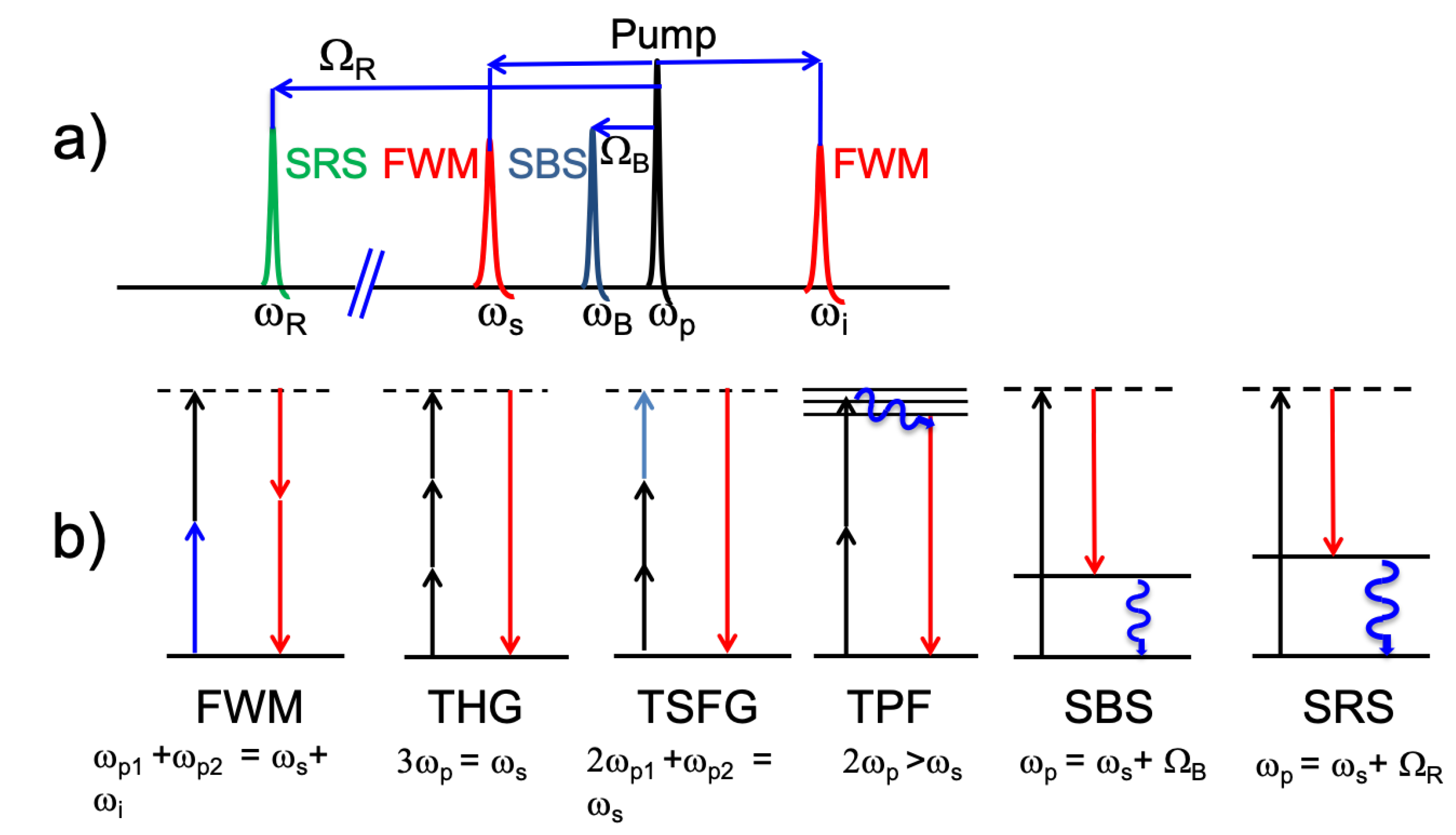

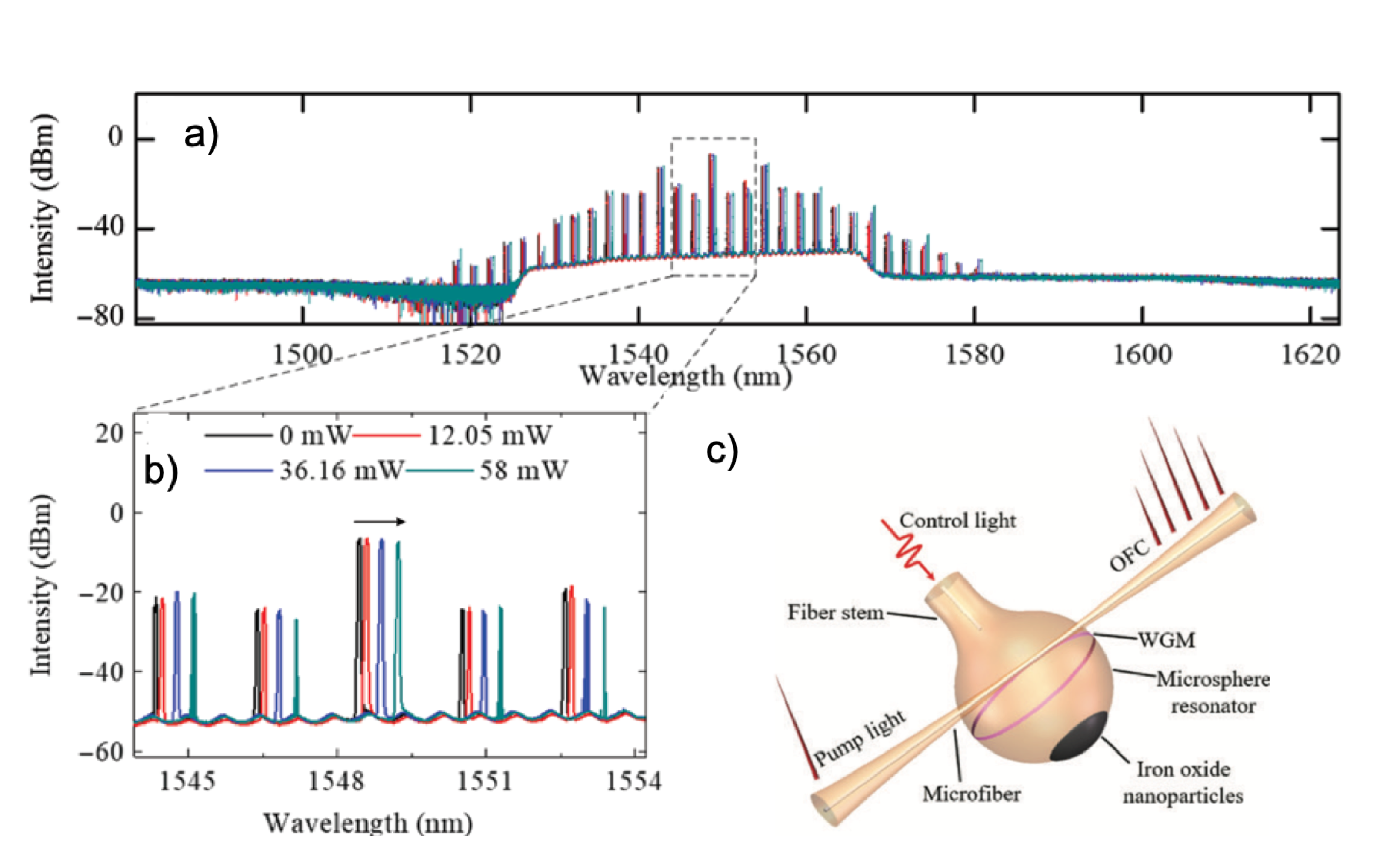
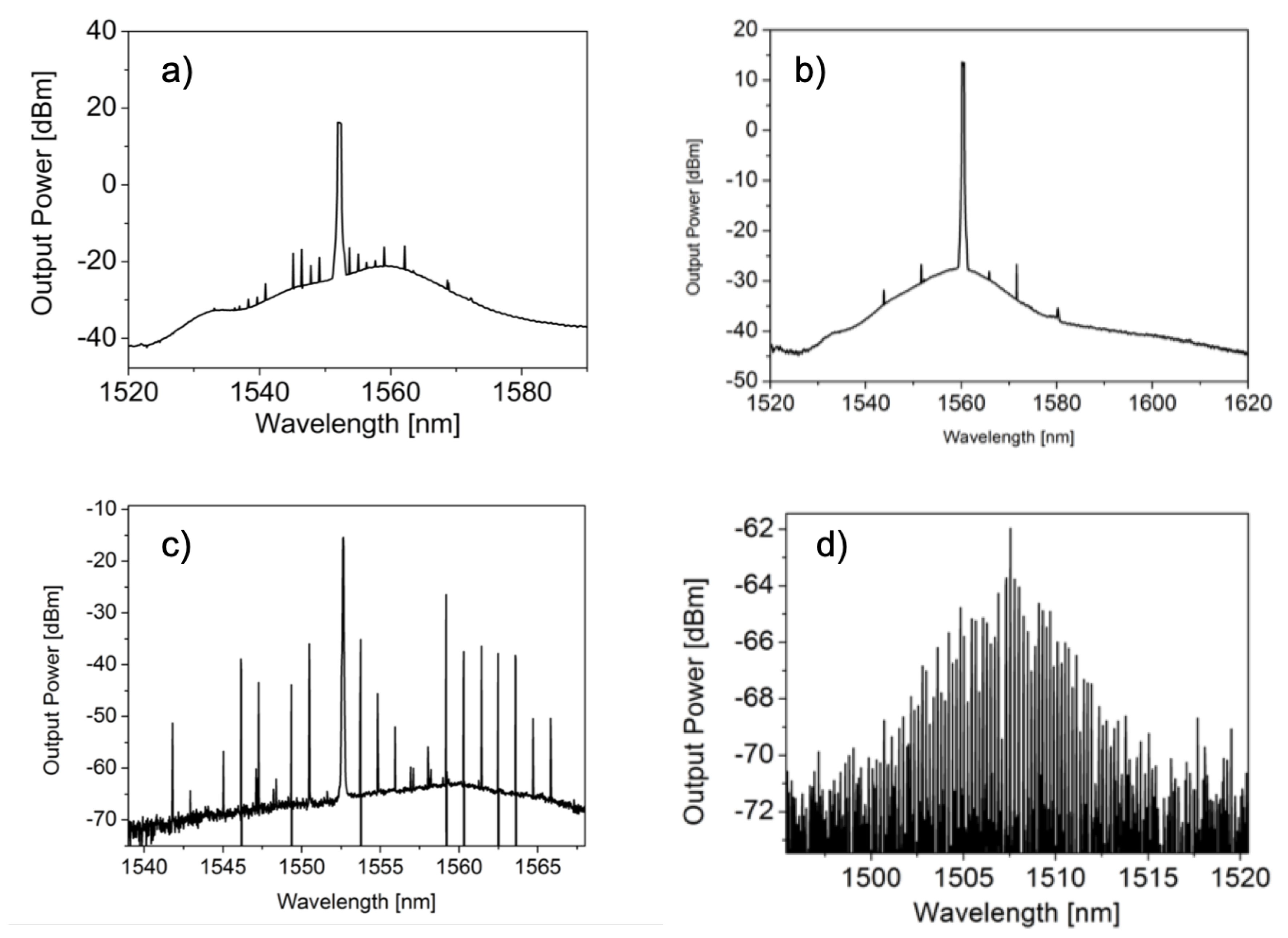
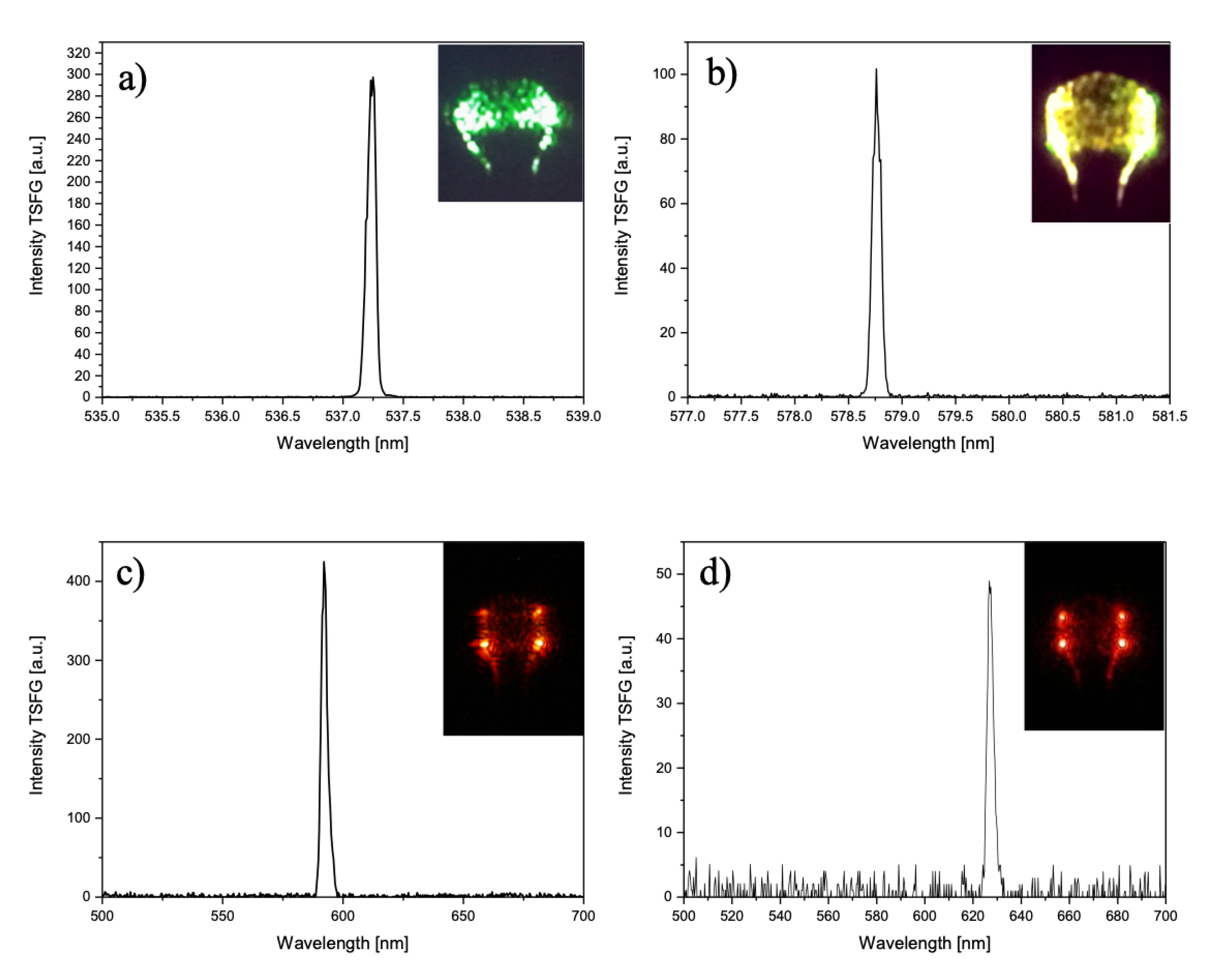
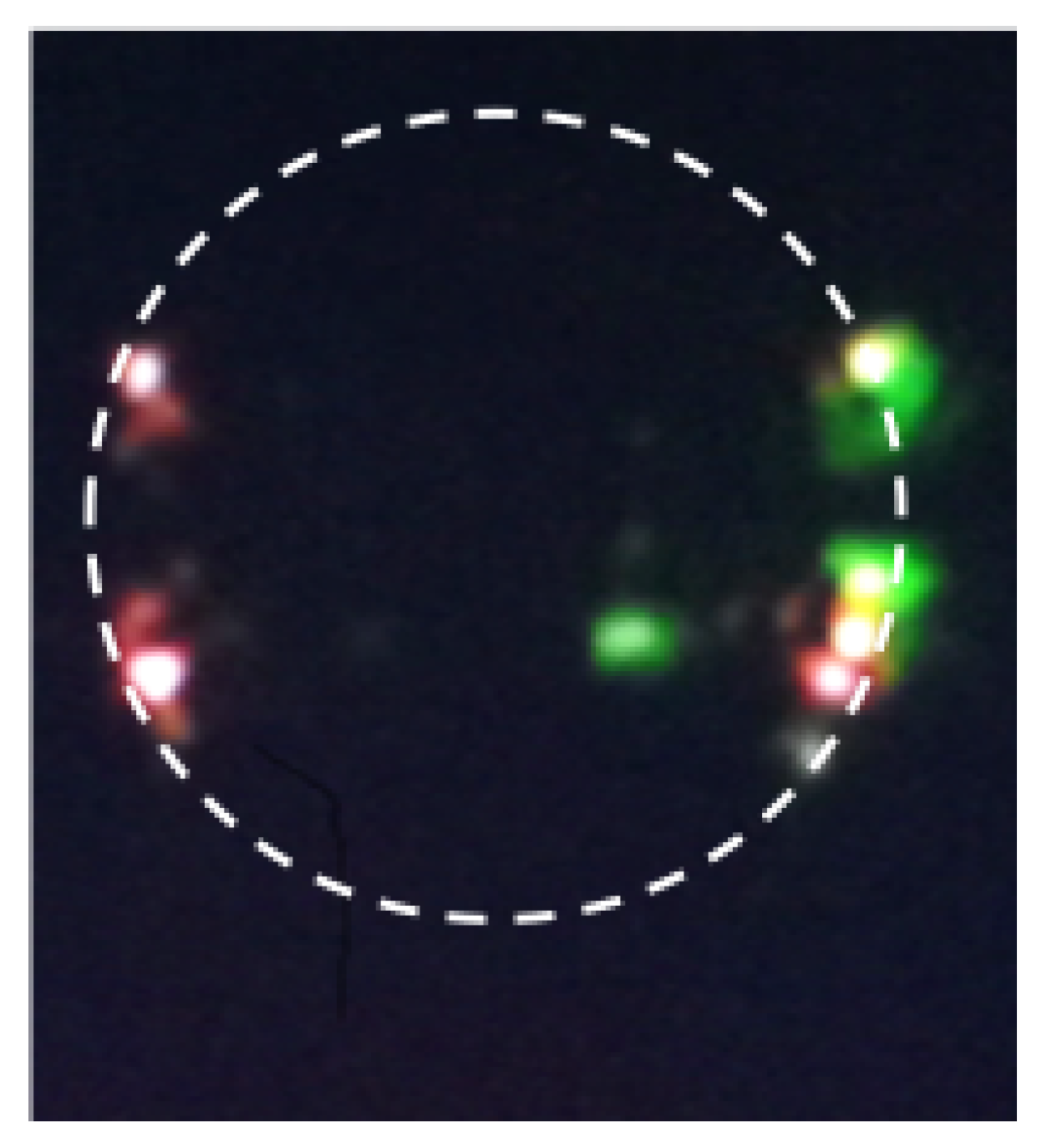
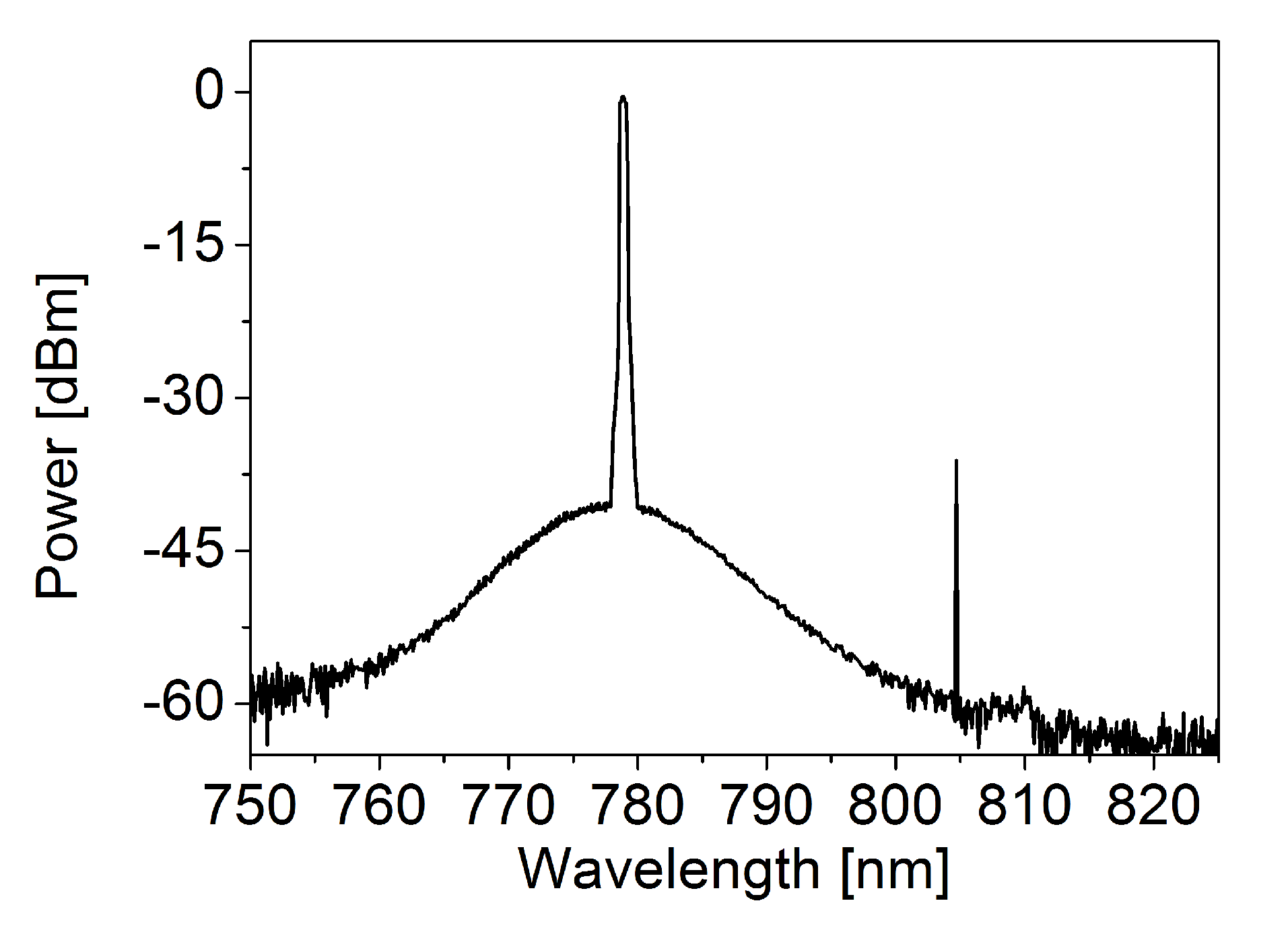
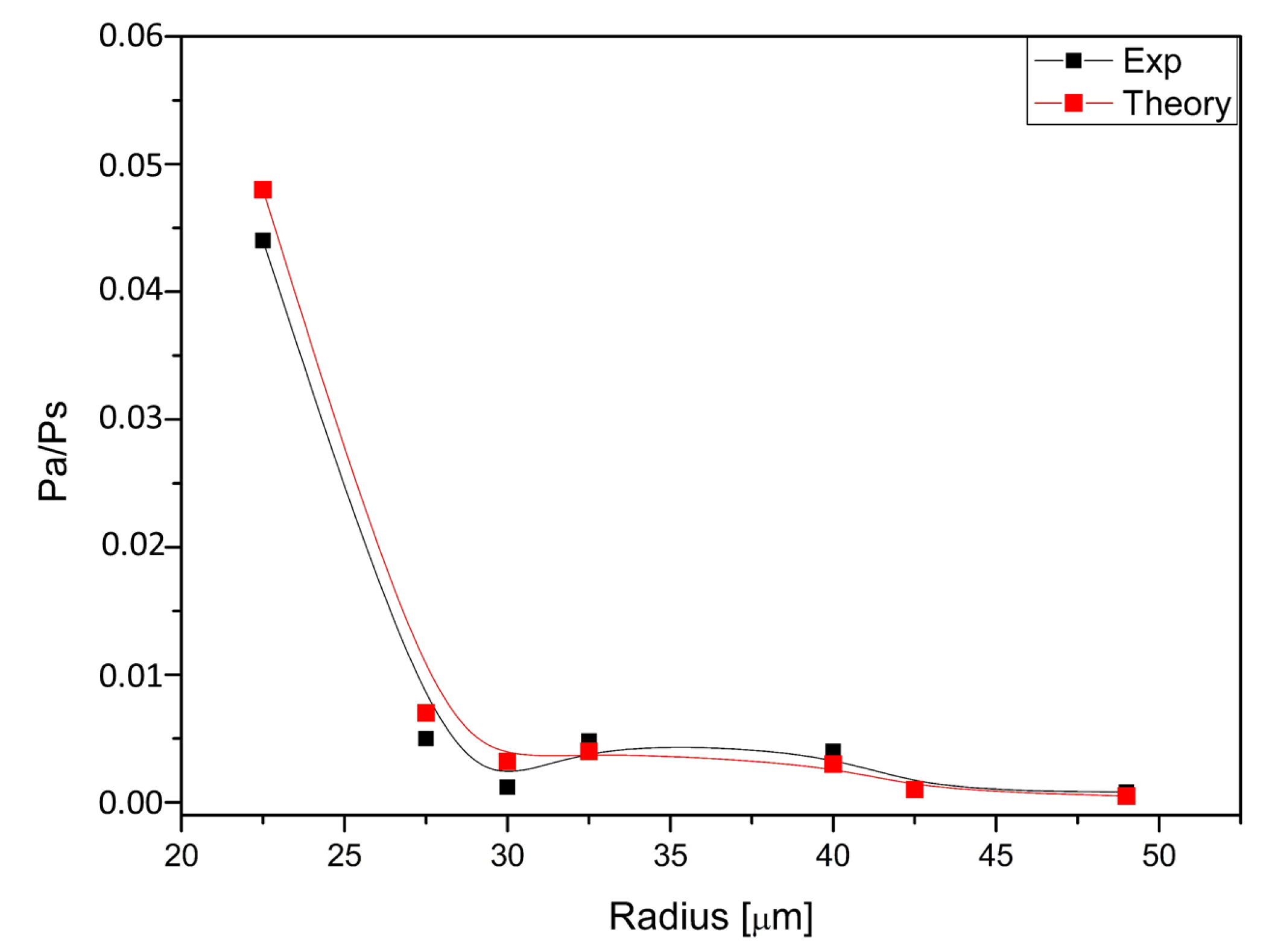
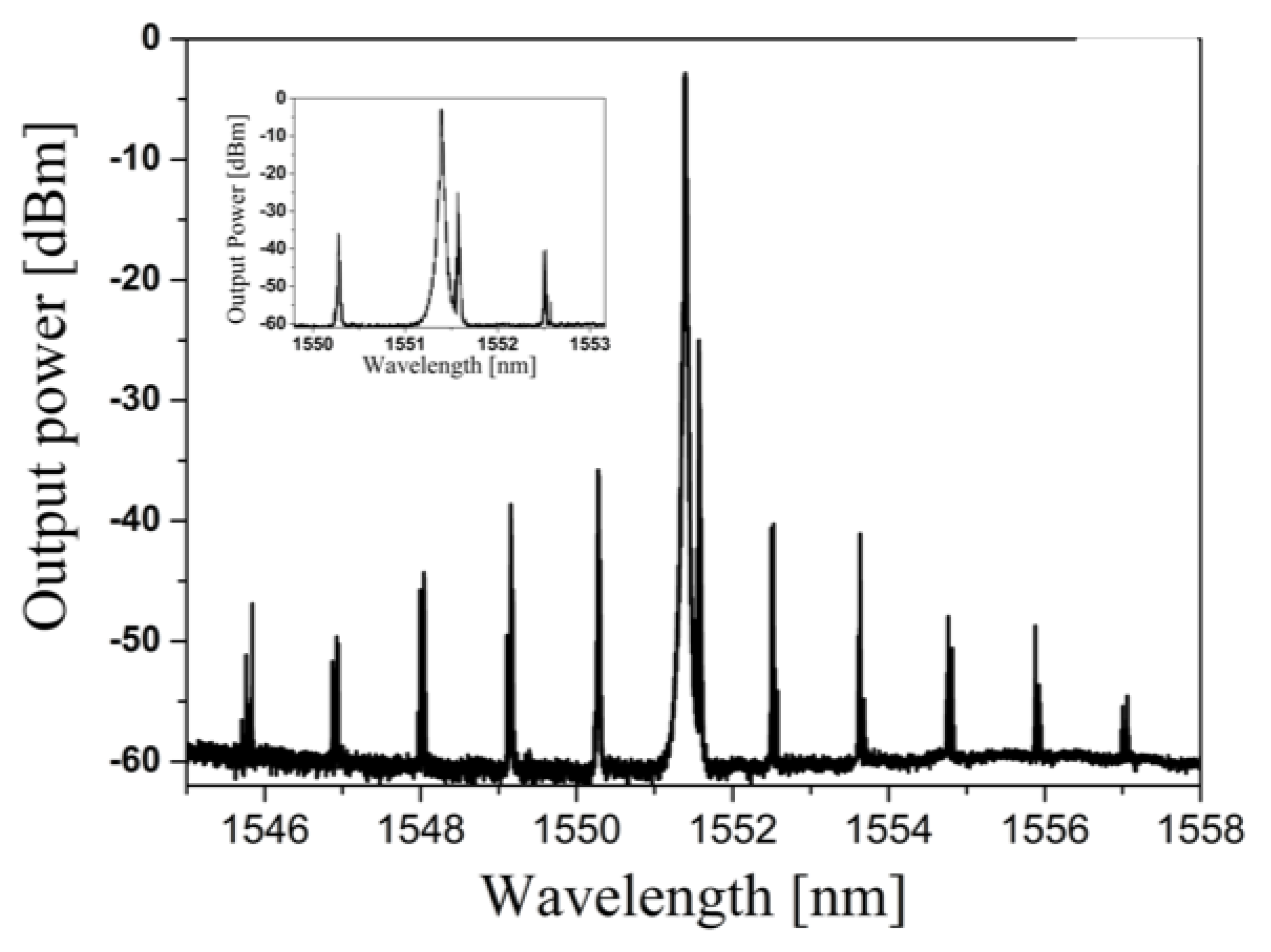
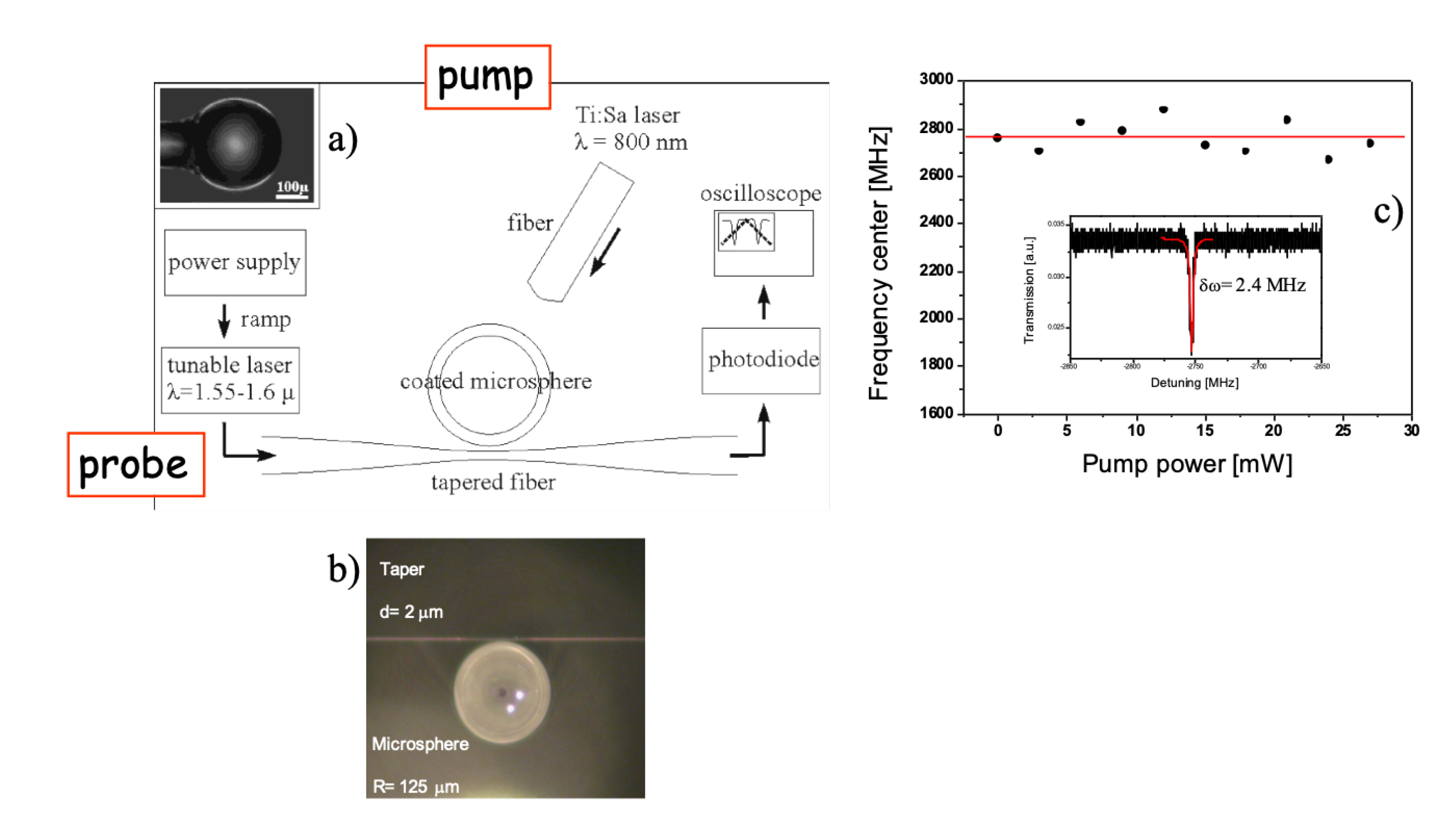
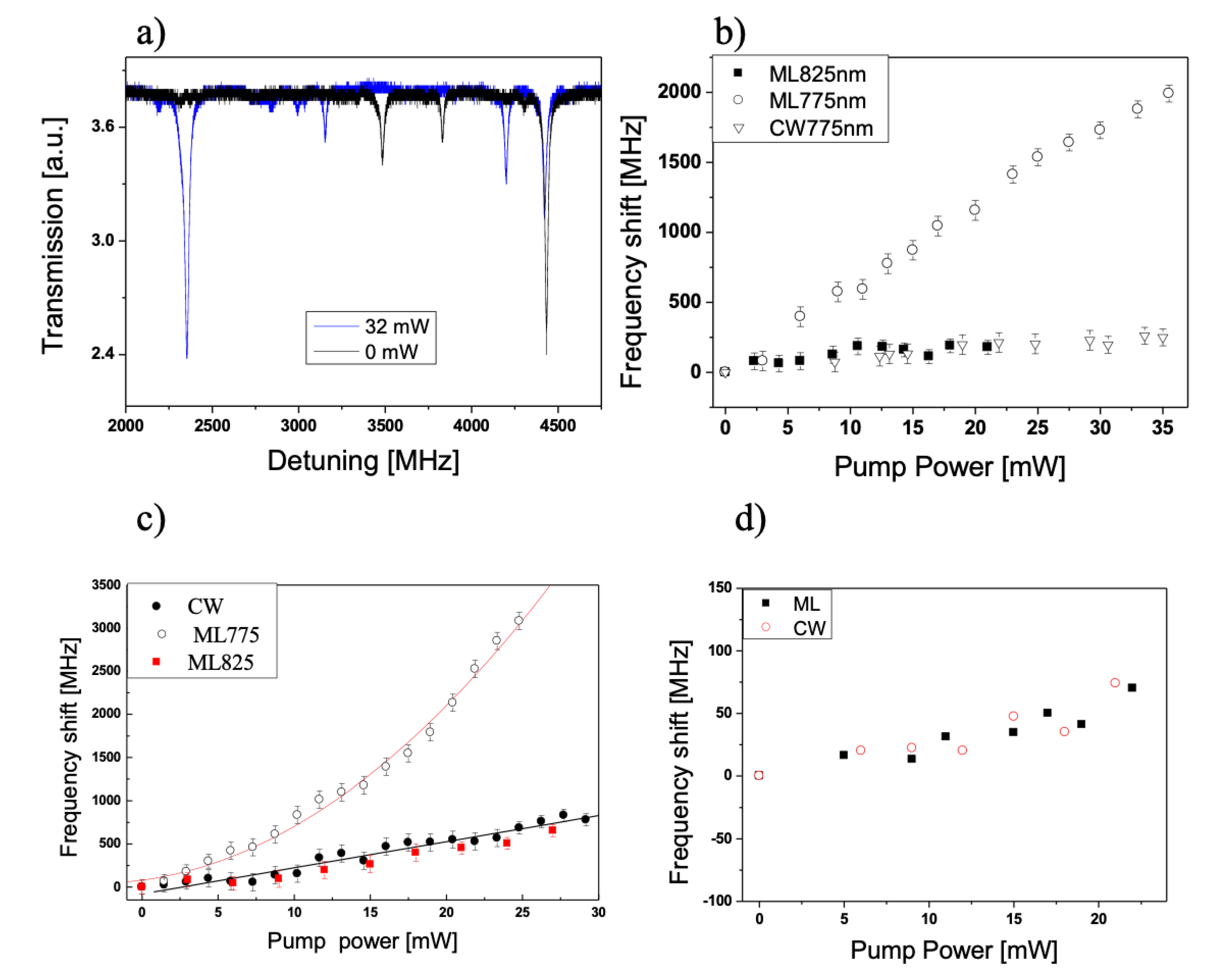


© 2020 by the authors. Licensee MDPI, Basel, Switzerland. This article is an open access article distributed under the terms and conditions of the Creative Commons Attribution (CC BY) license (http://creativecommons.org/licenses/by/4.0/).
Share and Cite
Frigenti, G.; Farnesi, D.; Nunzi Conti, G.; Soria, S. Nonlinear Optics in Microspherical Resonators. Micromachines 2020, 11, 303. https://doi.org/10.3390/mi11030303
Frigenti G, Farnesi D, Nunzi Conti G, Soria S. Nonlinear Optics in Microspherical Resonators. Micromachines. 2020; 11(3):303. https://doi.org/10.3390/mi11030303
Chicago/Turabian StyleFrigenti, Gabriele, Daniele Farnesi, Gualtiero Nunzi Conti, and Silvia Soria. 2020. "Nonlinear Optics in Microspherical Resonators" Micromachines 11, no. 3: 303. https://doi.org/10.3390/mi11030303
APA StyleFrigenti, G., Farnesi, D., Nunzi Conti, G., & Soria, S. (2020). Nonlinear Optics in Microspherical Resonators. Micromachines, 11(3), 303. https://doi.org/10.3390/mi11030303





